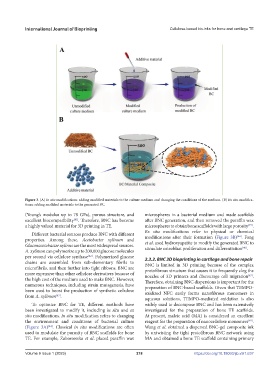Page 226 - IJB-9-1
P. 226
International Journal of Bioprinting Cellulose-based bio-inks for bone and cartilage TE
Figure 3. (A) In situ modifications: adding modified materials to the culture medium and changing the conditions of the medium. (B) Ex situ modifica-
tions: adding modified materials to the generated BC.
(Young’s modulus up to 78 GPa), porous structure, and microspheres in a bacterial medium and made scaffolds
excellent biocompatibility . Therefore, BNC has become after BNC generation, and then removed the paraffin wax
[41]
a highly valued material for 3D printing in TE. microspheres to obtain bone scaffolds with large porosity .
[45]
Ex situ modifications refer to physical or chemical
Different bacterial sources produce BNC with different [44]
properties. Among these, Acetobacter xylinum and modifications after their formation (Figure 3B) . Fang
et al. used hydroxyapatite to modify the generated BNC to
Gluconacetobacter xylinus are the most widespread sources. stimulate osteoblast proliferation and differentiation .
[46]
A. xylinum can polymerize up to 200,000 glucose molecules
per second via cellulose synthase . Polymerized glucose 2.3.2. BNC 3D bioprinting in cartilage and bone repair
[42]
chains are assembled from sub-elementary fibrils to BNC is limited in 3D printing because of the complex
microfibrils, and then further into tight ribbons. BNC are protofibrous structure that causes it to frequently clog the
more expensive than other cellulose derivatives because of nozzles of 3D printers and discourage cell migration .
[47]
the high cost of the medium used to make BNC. However, Therefore, obtaining BNC dispersions is important for the
numerous techniques, including strain mutagenesis, have preparation of BNC-based scaffolds. Given that TEMPO-
been used to boost the production of synthetic cellulose oxidized NFC easily forms nanofibrous monomers in
from A. xylinum . aqueous solutions, TEMPO-mediated oxidation is also
[43]
To optimize BNC for TE, different methods have widely used to decompose BNC and has been extensively
been investigated to modify it, including in situ and ex investigated for the preparation of bone TE scaffolds.
situ modifications. In situ modification refers to changing At present, maleic acid (MA) is considered an excellent
the environment and conditions of bacterial culture reagent for the preparation of nanocellulose monomers .
[48]
(Figure 3A) . Classical in situ modifications are often Wang et al. obtained a dispersed BNC-gel composite ink
[44]
used to modulate the porosity of BNC scaffolds for bone by untwisting the tight protofibrous BNC network using
TE. For example, Zaborowska et al. placed paraffin wax MA and obtained a bone TE scaffold containing primary
Volume 9 Issue 1 (2023)olume 9 Issue 1 (2023)
V 218 https://doi.org/10.18063/ijb.v9i1.637

